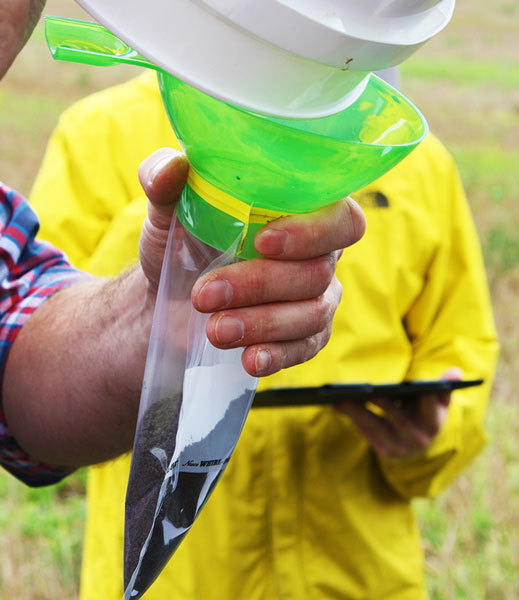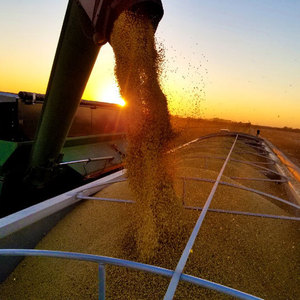Low-Carbon Connections



PHOTO: INDIGO AG
October 27, 2020
BY Matt Thompson
When Poet approached the Farmers Business Network more than two years ago, the goal was to find a way to connect large grain buyers, such as ethanol plants, to farmers who use sustainable practices. Doing so would allow ethanol plants to source low-carbon corn, while offering growers a premium for their commodities. After a successful pilot program at Poet’s Chancellor, South Dakota, plant, the two companies earlier this year launched Gradable, the platform that connects grain buyers and growers.
“Part of Poet’s mission is to be a good steward of the earth—and to look for all the ways we can do that—and we recognize that our agricultural inputs are a very important component of that,” says Bob Whiteman, Poet CFO.
Whiteman says the partnership with FBN allows for reliable scoring of a producer’s carbon intensity (CI). “We had to make sure that it would be a verifiable data point,” Whiteman says of the carbon scoring. “Without good science and data behind that carbon intensity value, any fruit from them would be short-lived. FBN was the only entity that we found whose technology was advanced enough to allow for that data gathering to take place in a way that would be verifiable, yet convenient for the agricultural producer.”
Whiteman says growers who participate in Gradable don’t risk giving confidential data to the ethanol industry, as FBN houses all the data for the growers. “Agricultural producers, very understandably, would not be keen to provide all of their agricultural data to a biofuel producer,” he says. Whiteman explains that FBN is “the data aggregator and they have the tools that allow for the farmer or the producer to be able to see the impacts of what they do, see what other folks are doing in a similar space, and make the relevant economic decisions.” The only information Poet receives, he says, is the CI score of the grain that is delivered to Poet.
And while CI scores are important for ethanol plants selling to California, Whiteman says the California Air Resources Board doesn’t allow producers to override the default value of agricultural inputs under the state’s Low Carbon Fuel Standard. “Our belief was at the time, when this project started with FBN and was validated through that first year, that there is a pretty wide array of agricultural practices and some are are significantly better than the average, and unfortunately, some are significantly worse than the average,” Whiteman says.
Advertisement
He adds that a meeting is scheduled for mid-October for CARB to evaluate the rulemaking, which may allow for the CI score of ag inputs to be overridden. “We know they see the merits of incentivizing agricultural production,” Whiteman says. “But they want to do it in a way that provides an assurance that the changes being made are genuine and actually improving the emissions associated with the lifecycle GHGs of ethanol production or other biofuels.”
Whiteman says it’s important to note that the Gradable program does not take into account soil organic carbon (SOC). “We’re not dismissing the science behind SOC changes; we believe that they’re very real. But we completely understand that regulatory bodies and environmental group concerns around the potential reversibility of some of those changes.” He uses no-till farming as an example, saying that because a farmer doesn’t till one year, doesn’t mean he or she couldn’t till again the following year. “We do believe that science will eventually get there—it will catch up to being able to monitor those things better—but we’re only focused on the direct life cycle emissions associated with [sustainable farming],” he says.
Grain Marketplace
Indigo Ag’s Marketplace is another platform connecting grain buyers and growers. Heather Gieseke, Indigo’s head of commercial marketplace strategy, says Indigo’s goals include improving farmer profitability and being good stewards of the environment. “Everybody focuses on sustainability, but it can be such a buzz word,” she says. “But what does sustainability really mean? So if I’m buying a bag of rice that I know is grown using 10 percent less nitrogen and 10 percent less water and 10 percent less greenhouse gas emissions, that’s something really meaningful in terms of the impact that that grower is having or not having on the environment. That was really the heartbeat of Marketplace: creating a mechanism to make those types of connections between buyers and growers.”
Indigo’s Marketplace was launched two years ago, and Gieseke says that in addition to ethanol producers, other grain buyers can take advantage of the program to source commodities with specific requirements. “The interesting thing about Marketplace is there’s a little something in Marketplace for everyone,” she says. “We can improve the efficiency of any kind of grain buyer across the country by helping them get access to a wider variety of customers than they’re used to talking to.” She adds that the goal of Marketplace isn’t to compete with grain buyers, but partner with them. “It really is just us helping to digitally connect the dots between growers and buyers, and any buyer in the U.S. can take advantage of that,” Gieseke says.
And, she says, there has been more of a focus on low-carbon and more sustainable commodities in recent years. That interest has come not just from the ethanol sector, but from energy companies as well, she says. “We launched our carbon program last summer and have had just such tremendous interest from customers wanting to participate in it, both farmers enrolling their acres and also companies that have partnered with us to purchase those carbon credits from farmers to neutralize that carbon footprint.”
In addition to Marketplace, Indigo’s offerings include a carbon program, which allows organizations to receive CI scores, and buy and sell carbon credits. By using Marketplace, she says, companies can source low-carbon grain, but in conjunction with Indigo Carbon, companies “can also look at their carbon footprint outside of the commodities that they’re using.” She says combining both offerings creates “one holistic approach to really do what’s right for the environment.”
Advertisement
Indigo executive Jon Hennek says the carbon program helps growers implement sustainable farming practices and then finds buyers for the carbon credits they generate. “We connect those two and pay growers to sequester that carbon and sell carbon credits to those companies,” he says.
He adds that many of Indigo Carbon’s customers are large companies, and that there aren’t any ethanol plants who have yet registered for the program, although they do work with growers who sell to ethanol plants. “We’re working mostly with large corporations who are looking to offset their carbon emissions, and then working with those growers,” he says. He also says the program is active in 21 states, most of which are in the Corn Belt.
Hennek says Indigo Carbon takes a three-pronged approach: measuring soil samples, collecting historical data from a grower’s operation, and using remote sensing and other data sources. The data collected is then plugged into a scientific model. “It’s a well-worn, scientifically proven model that allows us to measure what their trajectory was and what the change in practice that they moved towards, what the difference is between those two so we know how much carbon they’re sequestering because of the program,” he says.
Indigo Carbon was launched in June of 2019, Hennek says. “We’ve had over 21 million acres now of growers expressing interest on our website, and 7 million of those acres are signed up for the program and contracted in carbon,” he says. “It’s been really an amazing and very fast growth of the program.”
Gieseke agrees that interest in sustainability and carbon reduction has been on the rise in recent years. And, she says, Indigo expects that trend to continue. “There are so many groups that are looking into the future and saying, ‘We need to do business different. We need to think about the environment. We need to think about the things we’re doing and take a good, hard look in the mirror and say how can we do things differently.’ And that low carbon focus is the number one thing at the top of the list of things they can do to make a difference. We see that growing into a huge opportunity for agriculture and for farmers to play a leading role.”
Whiteman agrees. “With the Low Carbon Fuel Standard, sustainable agriculture, we believe there is a growing demand for it out there. This is not unique to the biofuels space, but food and fiber—very applicable to them as well. But what is unique to the biofuels space is it actually has an existing standard, both for measurement and valuation, of what are most sustainable practices worth. And we believe that’s a key underpinning to the project,” he says.
Author: Matt Thompson
Freelance Writer
mthompson@bbiinternational.com
Related Stories
A small but increasing amount of biodiesel in the United States is consumed in the residential, commercial, and electric power sectors, according to new estimates now published in the U.S. EIA’sState Energy Data System.
IAG and Microsoft are extending their 2023 co-funded purchase agreement for SAF by five years. The SAF used under the agreement will be produced by Phillips 66’s Humberside refinery and LanzaJet’s facility in the U.S.
U.S. exports of biodiesel and biodiesel blends of B30 or greater fell to 7,849.6 metric tons in February, according to data released by the USDA Foreign Agricultural Service on April 3. Biodiesel imports were at 21,964.9 metric tons for the month.
Neste and DB Schenker, a logistics service provider, have collaborated to work towards expanding DB Schenker’s adoption of Neste MY Renewable Diesel in Asia-Pacific. DB Schenker trialed the fuel from December 2024 to February 2025 in Singapore.
The International Air Transport Association has launched the Sustainable Aviation Fuel (SAF) Registry with its release to the Civil Aviation Decarbonization Organization. The registry is now live and under CADO management.
Upcoming Events










